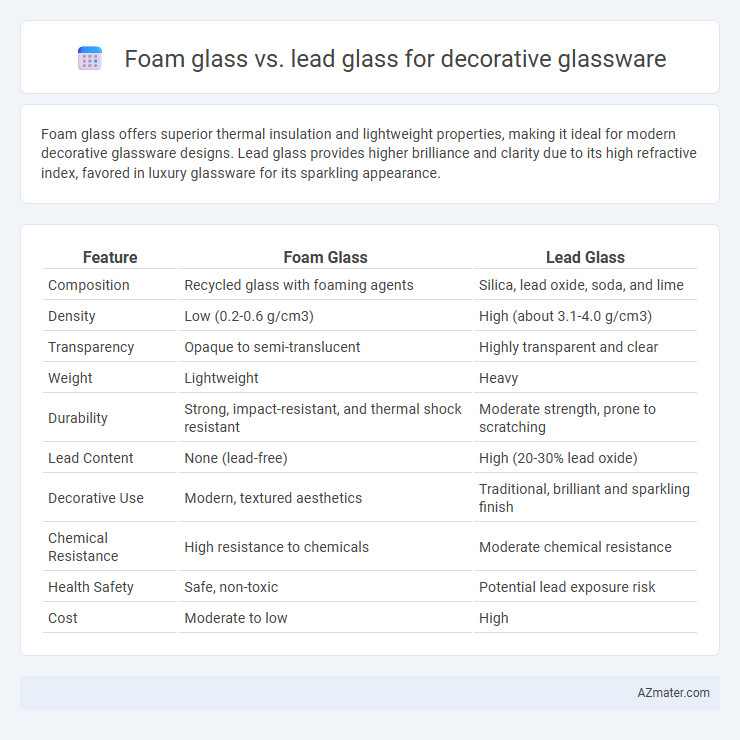Foam glass offers superior thermal insulation and lightweight properties, making it ideal for modern decorative glassware designs. Lead glass provides higher brilliance and clarity due to its high refractive index, favored in luxury glassware for its sparkling appearance.
Table of Comparison
| Feature | Foam Glass | Lead Glass |
|---|---|---|
| Composition | Recycled glass with foaming agents | Silica, lead oxide, soda, and lime |
| Density | Low (0.2-0.6 g/cm3) | High (about 3.1-4.0 g/cm3) |
| Transparency | Opaque to semi-translucent | Highly transparent and clear |
| Weight | Lightweight | Heavy |
| Durability | Strong, impact-resistant, and thermal shock resistant | Moderate strength, prone to scratching |
| Lead Content | None (lead-free) | High (20-30% lead oxide) |
| Decorative Use | Modern, textured aesthetics | Traditional, brilliant and sparkling finish |
| Chemical Resistance | High resistance to chemicals | Moderate chemical resistance |
| Health Safety | Safe, non-toxic | Potential lead exposure risk |
| Cost | Moderate to low | High |
Introduction to Decorative Glassware Materials
Foam glass and lead glass represent distinct materials used in decorative glassware, each offering unique structural and aesthetic properties. Foam glass is a lightweight, porous material known for its insulation and durability, making it suitable for decorative applications requiring strength and thermal resistance. Lead glass, enriched with lead oxide, provides superior clarity, brilliance, and weight, enhancing the visual appeal and refractive qualities essential for luxury decorative glassware.
What is Foam Glass?
Foam glass is a lightweight, porous material made from crushed glass combined with foaming agents and subject to high-temperature heating, resulting in a rigid, insulating structure. Unlike lead glass, which contains heavy metal oxides for increased density and brilliance in decorative applications, foam glass offers enhanced thermal insulation and durability, making it ideal for artistic designs that require both aesthetics and functional performance. Its unique cellular makeup provides sound absorption and resistance to moisture, distinguishing it from traditional decorative lead glassware.
Understanding Lead Glass
Lead glass, also known as crystal glass, contains high levels of lead oxide, typically between 18% and 40%, which enhances its refractive index and brilliance, making it highly prized in decorative glassware. Its dense structure and increased weight provide superior clarity and sparkle compared to foam glass, which is lightweight and porous due to its cellular composition. Understanding lead glass is essential for designers aiming to achieve luxurious aesthetics and intricate detailing in ornamental glass pieces.
Aesthetic Differences: Foam Glass vs Lead Glass
Foam glass features a matte, opaque appearance with a unique cellular texture that enhances modern, minimalist decorative glassware designs, while lead glass offers exceptional clarity and brilliance, creating an elegant, sparkling effect ideal for classic and luxurious aesthetics. The lightweight nature of foam glass allows for larger, sculptural pieces without compromising visual impact, contrasting with the dense, reflective qualities of lead glass which highlight intricate cuts and patterns. These distinct aesthetic differences influence the choice of material based on design goals, with foam glass emphasizing texture and form, and lead glass focusing on light refraction and traditional beauty.
Weight and Durability Comparison
Foam glass is significantly lighter than lead glass, making it ideal for decorative glassware that requires easier handling and reduced shipping costs. Lead glass offers superior durability and resistance to impact due to its higher density and lead content, providing enhanced longevity in decorative applications. Weight-sensitive projects benefit from foam glass, while lead glass is preferred when strength and scratch resistance are primary considerations.
Safety and Environmental Considerations
Foam glass offers superior safety and environmental benefits compared to lead glass due to its non-toxic composition and recyclability, eliminating the health hazards associated with lead exposure. Lead glass contains toxic lead oxide, posing significant risks during manufacturing, usage, and disposal, leading to potential contamination of water and soil. Foam glass is more sustainable, being made from recycled materials and providing excellent thermal insulation, making it a safer and eco-friendly choice for decorative glassware.
Color and Clarity in Decorative Applications
Foam glass in decorative glassware offers a unique matte and textured appearance with diffused light effects, providing muted colors and limited clarity ideal for artistic and opaque designs. Lead glass, known for its high refractive index and lead oxide content, delivers exceptional brilliance, clarity, and vibrant color dispersion, enhancing the visual appeal of transparent and intricate decorative pieces. The choice between foam glass and lead glass depends on the desired aesthetic effect, where foam glass emphasizes subtle color tones and matte finishes, while lead glass maximizes sparkle and color vibrancy.
Customization and Design Flexibility
Foam glass offers exceptional customization options with its lightweight structure and diverse textures, allowing for intricate shapes and vibrant finishes in decorative glassware. Lead glass provides superior clarity and brilliance, enabling precise engraving and detailed patterns ideal for luxury and classic designs. Both materials enhance design flexibility, but foam glass suits contemporary, tactile aesthetics while lead glass excels in traditional, high-clarity decorative applications.
Cost and Market Availability
Foam glass offers a cost-effective alternative to lead glass, with lower production expenses due to its lightweight and recyclable materials. Lead glass, however, is generally pricier because of its high lead oxide content and specialized manufacturing processes, limiting its widespread market availability. Foam glass enjoys broader distribution in decorative glassware markets, appealing to eco-conscious consumers seeking affordable, durable options.
Choosing the Best Glass for Decorative Glassware
Foam glass offers lightweight durability and excellent insulation, making it ideal for decorative glassware requiring strength and thermal resistance. Lead glass, known for its brilliance and clarity due to high refractive index, enhances aesthetic appeal but is heavier and less durable than foam glass. Selecting the best glass depends on prioritizing either lightness and durability with foam glass or sparkle and elegance with lead glass for decorative purposes.

Infographic: Foam glass vs Lead glass for Decorative glassware
 azmater.com
azmater.com